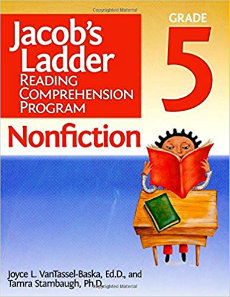Helping Middle Graders Master Nonfiction Texts
Jacob’s Ladder: Reading Comprehension Program, Nonfiction, Grade 5
By Joyce VanTassel-Baska and Tamra Stambaugh
(Prufrock Press, 2016 – Learn more)

The “skill and drill” portion of many reading lessons does an extreme disservice by failing to truly help students succeed. As students’ progress through the worksheets, it is easy to simply check them off a list because they did the work, but are they truly showing mastery of the specific standards we attempt to address?
Unfortunately, it is becoming too much about moving the student through the material, and there is much left by the wayside when it comes to evidence of true mastery. Drs. VanTassel-Baska and Stambaugh have devised a way to garner the most impact from nonfiction mini-lessons while allowing for flexibility and choice within the texts.

The research behind this program supports use and implementation with learners in varying grade levels, and “overlap to provide opportunities for teachers to select the most appropriate set of readings for meaningful differentiation for their learners’ needs” (pg. 10).
Climbing the rungs
Like lessons in other Jacob’s Ladder Reading Comprehension Programs, those in this book are organized by six “ladders” where each “rung” has a specific task or focus for students to master. As students progress up their ladders, their understanding and mastery of nonfiction texts improves. The bottom rung contains skills such as “sequencing” and “cause and effect,” while upper rungs focus on “using emotion” and “understanding words.” Essentially, as the students progress through the tasks the depth of skill required increases as well.
Though the lessons are intended to be presented in order, choosing “ladders” as the need / topic arises would work as well. Ladder A focuses on developing prediction and forecasting skills, while Ladder F focuses on word study. The design of the ladders allows for them to be addressed as the need arises, but as skills often build upon one another, the authors recommend beginning with A and working up to F.
At the end of the ladders, there is an overall “7th goal” which focuses on processing skills. Essentially, this is the tie-together-make-it-all-work ladder where students create and showcase their learning mastery.
Pre- and post-assessments included
There are pre-assessments and post-assessments to gauge the before-and-after status of the students and their understanding of the concepts. The assessments are geared towards helping students see where they are versus where they can (should) be and there is less of an academic “test” feel to them. They are presented as stories with constructed response answer opportunities where students can showcase their learning.
Included in the beginning of the book is a chart with the various topics and ladders and how they are addressed within the text (Table 2). The reading selections are organized by core subject (i.e. Math, Social Studies, Science, and the Arts) and there is a section of fiction and nonfiction comparisons as well.
This is not a comprehensive program meant to fully address classroom needs for teaching mastery of Informational Text Common Core State Standards (CCSS). Rather, it is a supplemental program to bolster the reading and exploration done in the classroom already.
Topics to interest your students
The texts selected are topical, relevant, and of high interest for most learners, though teachers may need to model more thoroughly with some of the texts.
The book includes appendix sections with rubrics to assess students through the readings, and the lessons contain all the necessary reproducibles, though some may also require loose paper or a notebook. Because goal setting has such a high impact on student learning, it is nice that the authors include a sheet specifically geared towards reflection and student improvement (pg. 172). Included in the back of the text is an organization for the CCSS and how and where the standards are covered with each reading.
Most beneficial to readers newly introduced to the Jacob’s Ladder Reading Comprehension Program is the “Implementation Considerations” found on page 13. This section of the books tells the specific who, what, where, when, why, and how of implementing the program, so it is, by far, the most important section to review.
Though use of this program alone will not single-handedly foster improvement with students, the structure and thoroughness of the material being presented will help teachers and their students showcase mastery of nonfiction texts.
Erin Corrigan-Smith is a middle school ELA teacher in a suburb of Atlanta. She has a B.A. and M.A. in English, and her focus of study is children’s literature. During the school year, she is faculty advisor to the Book Worms book club. In her downtime, she enjoys going to her family’s cabin in the North Georgia mountains, with her husband and dog, to read and relax.


































